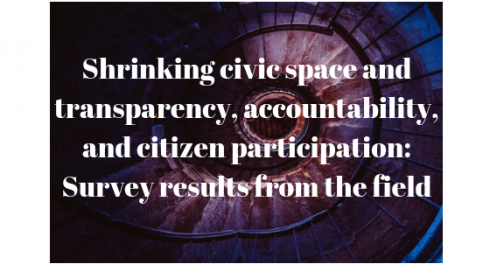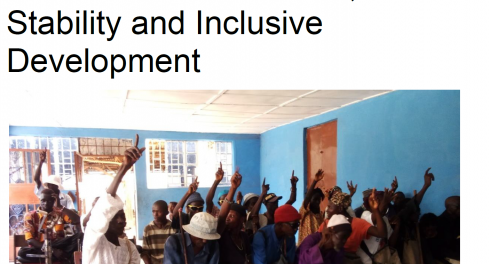In case you missed it…
Amid growing authoritarianism in different parts of the world, Mariz Tadros of IDS ponders whether accountability tools that so many of us have promoted, such as community scorecards, are simply providing regimes with “citizen engagement” gloss. If they don’t seriously challenge power asymmetries or the stifling of marginalized groups, are we in danger of mistaking the means for the end? David Sasaki of Hewlett Foundation asks similar questions about participatory budgeting (see his blog link in the TAI spotlight below).
Of course, there are tools that effectively suppress as well as engage citizens. Listen to arguments and delve into the Human Rights Initiative report on governments’ use of counterterrorism measures to justify limits on freedom of expression, association, and peaceful assembly (a topic also touched on in TAI’s recent report). Those organizations seeking to hold governments to account are among those affected. In the Philippines activists, including the UN Special Rapporteur for Indigenous Peoples, are tagged as “terrorists” which a local human rights group claims is part of a “long crusade against rights defenders”.
Compounding physical threats is shrinking digital space. Tech giants are increasingly being taken to task for their complicity. Hetan Shah is among the latest to argue platforms should be data stewards, not data owners, and suggests ways by which social media companies can ensure that personal data is used for the common good. That doesn’t mean we are individually off the hook. Rebecca Ricks argues it is high time we were smarter about corporate surveillance.
She may find inspiration in the fact that Dutch voters have rejected a “Big Brother Charter” that would have allowed the government to carry out surveillance and collect peoples’ electronic data. Media and technology may also be harnessed more positively. Engagement Lab highlights the potential of what they term “civic media practice” to facilitate democratic processes.
Continuing the search for more positive notes, we often talk of the need to connect proactively disclosed data to addressing real-world problems and several stories caught our attention in this vein this week from fighting organized crime to solving traffic problems. The Local Interventions Group launched the “Follow the Money” project to track disaster funding from district to village levels in Nepal. Tech startups are using data to fight organized crime in Brazil. In New York, resident Alex Bell uses open data and a computer algorithm to detect when and where road lanes are blocked.
At the institutional level, Pew Charitable Trusts makes the claim for the transformative value of administrative data at the subnational level and offer recommendations on the use of data for decision-making. Apolotica reinforces the point, highlighting the value of open data for civil servants and offering direct examples of inspiring government data champions from around the world. Still haven’t satisfied your data wonk needs? ICTWorks recommends long reads on three data types – thick data, adjacent data, and lean data. A prize for whomever intuitively knows the difference.
Returning to authoritarian tendencies, calls are growing to respond where it hurts i.e. in the wallet. Edward Luce points to autocrats’ fears of “transparent accountancy” and the need to tackle anonymous corporations that can be a vehicle to launder assets. Where to start? The US and UK. Anders Aslund backs the need for action as he digs deep into Russian crony capitalism. However, we shouldn’t underestimate positive outliers and a possible generational shift to come. We don’t often associate transparency with pizza, but The Economist flagged the rise of pizza chain Dodo whose founder “wanted to prove that you can be honest and transparent in Russia.” Transparency is a way for an entrepreneur to protect him/herself from a corrupt system.
When public monies do disappear, how do you get people to care? Global Witness offers one way – translate the losses into social costs. As detailed in the New Statesman, they point to long-term economic impacts of the Car Wash scandal in Brazil that they equate to a years’ worth of education for 17 million children or the salaries of more than a million nurses.
Global Witness has been doubly busy this week, also detailing potential complicity of Exxon in Liberian oil sector corruption. It appears that the fine lines between what is legal and what is not can be stretched gossamer thin. (See video below for the report’s summary.)
Would OECD’s High-Level Reporting Mechanism (HLRM) help in high-risk contexts like Liberia? The OECD is optimistic this new tool will result in a whole-of-a-society anti-corruption approach by targeting bribery and other illicit behavior in public procurement.
Systemic corruption would certainly count as a “wicked problem” meriting a collective approach. Gianluca Elia and Alessandro Margherita offer a conceptual framework and “collective intelligence system” to tackle such complex social issues. Another tool that could be useful? USAID’s collaboration map that allows an organization to graphically depict relationships, the level of interaction and influence with key stakeholders.
An organization’s theory of change must be periodically tested based on emerging evidence argues Michael Moses. He shares 3 general principles that guide Global Integrity’s monitoring, evaluation and learning – 1) emphasize local action, 2) support participation and 3) embrace iteration. But for data to be used for learning and adapting, it must first be accessible. Jennifer Lyons shares tools for visualizing qualitative data – Evergreen Data’s qualitative reporting series and USAID’s qualitative chart chooser.
TAI members have been exerting greater efforts to walk the talk on transparency lately. Last week, we posted David Sasaki’s reflection on Hewlett Foundations’ approach to participatory budgeting. In February, DFID launched their transparency agenda, and Open Society Foundations made public its new strategy on fiscal governance in a two-part blog series. Global Integrity welcomed the step and provided comprehensive feedback on what they specifically liked and where they would have wanted more. For our part, TAI will soon be publishing learnings from our work in 2017 and how these are guiding planning in 2018.
Finally, we are excited that Ruth Levine, as Hewlett Foundation’s institutional lead, takes over as Chair of TAI this month. Huge thanks to Julie McCarthy of Open Society Foundations for holding the mantle so long and so expertly!
TAI spotlight
- Hewlett Foundation Announces $10 Million Commitment to Support Research on U.S. Democracy’s Digital Disinformation Problem –New two-year grant to focus on research looking into potential solutions to digital disinformation and the practical and the philosophical consideration
- Participatory Budgeting: Spreading Across the Globe – New report seeks to support citizens, governments, practitioners and donors on how participatory budgeting can improve the quality of democracy, service delivery, community trust, and well-being.
- ‘100&Change’ Solutions Bank: A Unique Resource for Funders – Test drive MacArthur Foundations’ public database of projects, solutions and ideas – a repository of submissions of the 100&Change What would it reveal about the governance
Read our latest blogs!

David Sasaki reflects on evidence generated from two commissioned reports on the challenges and opportunities in participatory budgeting.

TAI donor members walking the talk on donor transparency and
collaboration. Explore what we fund on tax and why by Lauren Keevill

Help us crowdsource for The State of Open Data review. Comments by April 8. Click here for more information.
Of potential interest
- N Investigators Cite Facebook Role in Myanmar Crisis – UN cites Facebook as platform for the spread of hate speech against Rohingyas
- S. Authorities Get Access to Data Stored on Overseas Cloud Servers -A new deal signed by President Donald Trump allows US investigators access to data stored on overseas cloud servers, but raises concern among privacy and human rights activists
- 10 Tips for Collaborative Data Journalism Projects by Mar Cabra – Mar Cabra shares tips for collaborative data journalism projects; launches new resource hub for the data journalism community
- Where Does Foreign Aid Go? – A short video on who gives the most aid and to where?
- Artificial Intelligence, The Great Disruptor – New report assess the potential benefits and potential negative consequences of AI
- World’s Biggest Crypto Exchange Leaves Asia for Malta – Binance is moving to Malta, which has the lowest corporate tax rates in the EU, after receiving regulatory warnings from Hong Kong and Japan
- Blockchain & Distributed Ledger Technology (DLT) – World Bank publishes its first note on finance technology, looking at the implications of blockchain and distributed ledger technology for international development
Calls
Impact of Corruption and State Capture on Women – Call for Short Term Consultants – April 9
Present or Lead a Session: MERLTech DC – April 30
A Call for Ideas Seeks Solutions to Curb the Spread of Misinformation – May 31
On the calendar
- Collective Impact Convening– April 3-5, 2018 (Austin, TX)
- NPQ Live Conversation with Hillary Pennington on Ford’s BUILD Initiative – April 5
- Diplomatic Dialogue: Good Governance in Nigeria – April 7 (Lagos, Nigeria)
- Foundation Effectiveness: What It Takes – April 11 (New York, USA)
- 8th Summit of the Americas (“Democratic Governance Against Corruption”) – April 13-14 (Lima, Peru)
- A Return to ‘Governance in Dark Times’? Creating Spaces for Citizen Dialogue, Encouraging Engagement in Public Life, and Ensuring Government Transparency and Accountability – April 12-14 (Orlando, Florida, USA)
- The Value of Evaluations at the Hewlett Foundation (webinar) – April 19
- TicTec 2018: The Impacts of Civic Technology Conference– April 18-19 (Lisbon, Portugal)
- Grantmakers for Effective Organizations National Conference – April 30 – May 2, 2018 (San Francisco, CA)
- OpenGov Week – May 7- 11
- RightsCon (human rights in the digital age) – May 16 – 18 (Toronto, Canada)
- OGP Global Summit 2018 – July 17- July 19 (Tbilisi, Georgia)
- The Future is Open: 5th International Open Data Conference – September 20-21, Buenos Aires
- Evaluation for More Resilient Societies – October 1-5 (Greece)
- 18th International Anti-Corruption Conference – October 22-24 (Copenhagen, Denmark)
- BigSurv18 – Spain, Oct 25-27 (Barcelona, Spain)



